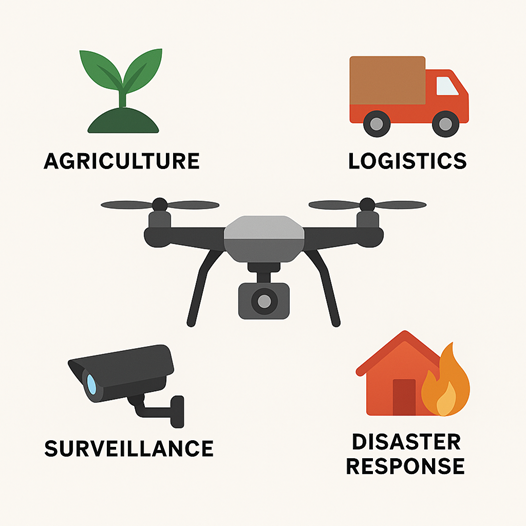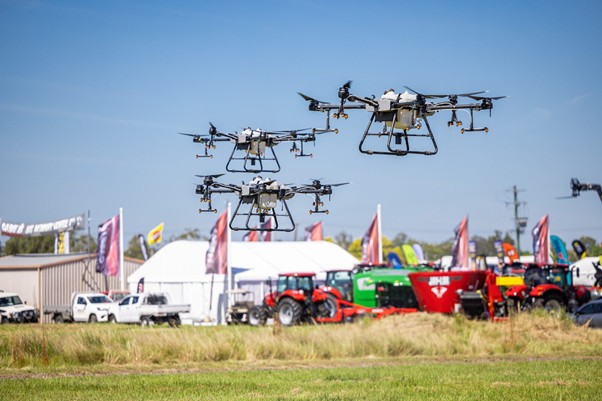Introduction: The Age of Drones
In just a decade, drones—or, in aviation terminology, Remotely Piloted Aircraft Systems (RPAS)—have shifted from being on the fringes of hobbyist culture to becoming central to technological innovation. What was once primarily used for aerial photography or recreational flying is now employed in precision agriculture, logistics, maritime surveillance, disaster response, and even national défense. Globally, governments and industries are preparing for the next stage: integrating drones as a key part of air transportation systems.
Indonesia’s geography makes it especially suitable for drone adoption. With over 17,000 islands, the second-longest coastline in the world, and extensive maritime borders, the country serves as an ideal testing ground for drone applications. Imagine drones delivering vaccines to remote villages in Papua, monitoring illegal fishing in Natuna, or assessing forest fires in Kalimantan. The possibilities are vast.
However, potential alone doesn’t guarantee progress. The essential, yet often overlooked, prerequisite is safety and governance. Without a strong regulatory framework, technical expertise, and a safety culture, drones could not only become ineffective but also pose risks to aviation and society.
Many advanced nations recognized this early, with Canada, for example, establishing comprehensive knowledge requirements for drone pilots. This ensures that even small RPAS operators understand air law, human factors, meteorology, and communication protocols. Indonesia doesn’t need to replicate such frameworks entirely, but the key lesson remains that drones are not toys. They are aircraft, and their integration into national airspace requires professional standards similar to those of manned aviation.
Indonesia’s Regulatory Gap: Between Over-Regulation and Under-Regulation
At present, Indonesia’s regulatory environment for drones is basic. Current rules focus primarily on:
- Mandatory registration of drones above a certain weight.
- Maximum flight altitude, usually capped at 150 meters.
- Prohibitions in sensitive areas such as airports, presidential palaces, and national vital objects.
- Licensing for certain commercial uses.
These are sensible first steps, but they remain partial. Regulations stop short of distinguishing between levels of drone operations—whether simple visual line-of-sight (VLOS), extended VLOS (EVLOS), or complex beyond visual line-of-sight (BVLOS) missions that require integration with manned aviation.
This lack of classification creates two opposite dangers:
- Over-regulation: innovation is stifled when blanket restrictions treat all drone activity as equally risky, discouraging commercial and research applications.
- Under-regulation: without clear standards, drones may operate freely without adequate safety measures, creating real hazards for manned aviation.
Indonesia urgently needs a competency-based framework. A weekend hobbyist flying a camera drone in an empty field should not face the same regulatory burden as a logistics operator planning BVLOS deliveries across mountainous Papua. Conversely, advanced operators must meet stricter requirements—advanced certification, technical redundancy, and oversight mechanisms.
Without such differentiation, Indonesia risks missing opportunities while simultaneously exposing itself to preventable accidents.
Technical Challenges: Batteries, Data Links, and Autopilots
Most drone incidents worldwide are not caused by reckless flying but by technical failures. In Indonesia, the same pattern emerges drones crashing due to motor failure, battery depletion, or lost communication links.
Many hobbyist communities still adopt a simplistic view of maintenance—charging batteries, checking propellers, and flying immediately. This is insufficient. Technical literacy requires understanding issues such as:
- Battery discharge curves: Lithium-ion batteries degrade over time. Without monitoring their declining capacity, drones may lose power mid-flight, leading to uncontrolled crashes.
- Radio frequency interference: In dense urban areas, Wi-Fi routers, cell towers, and other electronics can disrupt control signals, causing lost link scenarios where drones drift or fly away.
- Autopilot software and firmware management: Outdated or incompatible software can compromise navigation and flight stability. Without proper version control, even small glitches can cause catastrophic outcomes.
Canada, the European Union, and the United States embed such technical understanding into drone pilot certification. Indonesia must do the same. Operators should not only know how to fly but also why systems fail—and how to mitigate those risks.
Otherwise, every drone in the sky remains a potential hazard.

Human Factors: Safety Begins with the Operator
Aviation has long recognized that human factors, not mechanical faults, are the leading contributors to accidents. The same holds for drones. Even the most sophisticated RPAS is only as safe as its operator.
Consider these factors:
- Fatigue and workload: An operator conducting hours of aerial mapping may experience declining alertness and missing visual cues of approaching hazards.
- Medication and substance use: Even over-the-counter drugs can impair reaction times and judgment, yet few drone operators in Indonesia receive guidance on this.
- Situational awareness: Maintaining awareness of airspace conditions, surrounding obstacles, and weather is critical. Losing this awareness, even briefly, can result in conflicts with manned aircraft.
- Safety culture: In many Indonesian operations, profit or client pressure overrides safety considerations. This is unsustainable.
Currently, Indonesia lacks a structured approach to embedding human factors into drone training. Few operators conduct pre-flight briefings, role assignments, or emergency planning. Many operate alone, improvising as issues arise.
If Indonesia wants to scale drone use safely, it must institutionalize human factors education—covering physiology, psychology, stress management, and decision-making—just as in manned aviation. Safety begins with people, not machines.
Meteorology and Navigation: The Tropical Challenge
Indonesia’s weather patterns are notoriously unpredictable. Clear skies can quickly turn into heavy rain; calm winds into sudden gusts. This makes meteorology one of the most challenging aspects of drone operation in the tropics.
Without training, operators often underestimate wind speeds or ignore the impact of humidity. A drone attempting to hover in 25-knot winds may suddenly lose stability, veering off course or falling into the sea.
Equally concerning is the lack of navigational literacy. Many Indonesian operators rely solely on consumer apps like Google Maps for planning. Few know how to interpret aeronautical charts, recognize no-fly zones, or calculate flight distances relative to controlled airspace.
This ignorance poses real risks. Near airports, drones without proper navigation knowledge may inadvertently enter the approach paths of commercial aircraft, endangering lives.
Meteorology and navigation are not optional knowledge; they are fundamental. Indonesia must integrate them into training curricula and certification exams, ensuring that every operator—from hobbyist to professional—can read weather conditions and airspace data with competence.
Operational Safety: From VLOS to BVLOS
There is a world of difference between VLOS operations, where the pilot can see the drone, and BVLOS missions, where the aircraft may fly kilometers away, beyond direct visual control.
VLOS is relatively manageable for beginners, as long as flights are kept away from crowded areas and under altitude limits. But BVLOS—essential for logistics, maritime patrol, or infrastructure monitoring—requires entirely different safeguards:
- Redundant communication systems to prevent lost link scenarios.
- Emergency procedures and return-to-home protocols.
- Integration with air traffic control to avoid conflicts with manned aircraft.
- Oversight by aviation authorities.
Indonesia has already piloted BVLOS logistics in Papua, delivering medical supplies to remote villages. This is promising. Yet, without comprehensive regulations, certification standards, and monitoring systems, such missions remain risky. A single accident could undermine public trust and delay innovation for years.
The lesson is clear: BVLOS operations should be allowed—but only for certified operators meeting strict technical and procedural requirements. Safety cannot be an afterthought.
Radio Communication and ATM Integration
Perhaps the most overlooked challenge in Indonesia is radio communication. In mature aviation ecosystems, drone operators are often required to hold an aeronautical radio license, enabling them to communicate with control towers and other aircraft.
In Indonesia, very few drone operators possess this literacy. Drone flights exist in a parallel communication universe, disconnected from air traffic management (ATM). This siloed approach is unsustainable as skies grow more crowded.
If Indonesia is serious about integrating drones into national airspace, it must embrace Unmanned Traffic Management (UTM) systems. UTM will only work if drones can share real-time data with manned aviation, using standardized radio communication and phraseology.
Without this integration, the risk of mid-air conflicts—especially in urban environments or near airports—will increase dramatically. Radio literacy is not a luxury; it is the bridge that connects drones to the wider aviation system.
A Policy Roadmap for Indonesia
How, then, should Indonesia proceed? The answer lies in a holistic roadmap that balances safety, innovation, and sovereignty. At least five strategic priorities emerge:
- Competency-Based Regulation
Classify operations into basic, advanced, and BVLOS. Each class should require corresponding knowledge, certification, and operational safeguards. This ensures proportionality: simple flights remain accessible, while complex missions meet higher standards. - National Training Curriculum
Establish accredited training centres that cover not just flying skills but also meteorology, navigation, radio communication, and human factors. This curriculum should mirror international best practices while adapting to Indonesia’s tropical geography and unique challenges. - Safety Culture and SMS
Introduce Safety Management Systems (SMS) for drone operations, even at the community level. Encourage operators to conduct risk assessments, pre-flight briefings, and emergency planning. Safety must become a habit, not an afterthought. - ATM/UTM Integration
Empower AirNav Indonesia to develop and manage a national UTM platform, linking drones to existing air traffic systems. Mandate radio communication standards and integrate drone surveillance into national airspace management. - International Collaboration
Partner with global regulators such as Transport Canada, the European Union Aviation Safety Agency (EASA), and the International Civil Aviation Organization (ICAO). Collaborative alignment will prevent Indonesia from being isolated while giving local industries access to global markets.
Conclusion: Drones as Strategic Infrastructure
Indonesia stands at a crossroads. On one hand, the nation’s geography makes it a natural candidate for pioneering drone applications. On the other hand, the absence of comprehensive regulation, technical literacy, and integration mechanisms leaves the country vulnerable to accidents, inefficiency, and even security threats.
The choice is clear: Indonesia must move beyond partial rules and ad hoc enforcement toward a fully integrated drone ecosystem. Such an ecosystem would treat drones not as toys but as strategic infrastructure—governed by law, guided by knowledge, and powered by innovation.
Canada’s experience, along with other international models, shows that this is achievable. But ultimately, success will depend not on imported frameworks but on Indonesia’s own political will and institutional consistency.
Drones are the future of aviation. The question is whether Indonesia will shape that future proactively or remain a passive consumer of global standards. If the nation acts decisively—building competency-based regulation, training curricula, safety culture, and ATM integration—drones can become a pillar of national development: connecting islands, safeguarding borders, and empowering communities.
If not, they may remain little more than sophisticated toys, flying precariously in skies that demand professionalism.
The stakes could not be higher. Indonesia’s drone journey is not about gadgets; it is about sovereignty, safety, and the future of aviation itself.

